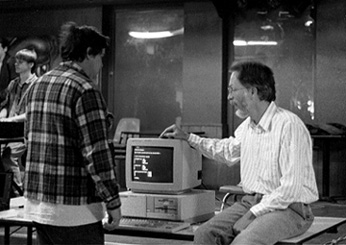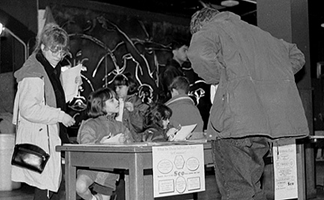








 At last Wednesday's disability fair, students had the opportunity to simulate and learn about diseases and disorders that affect some of their fellow students, as well as celebrities like Ray Charles, Annette Funicello, Whoopi Goldberg and Magic Johnson.
At last Wednesday's disability fair, students had the opportunity to simulate and learn about diseases and disorders that affect some of their fellow students, as well as celebrities like Ray Charles, Annette Funicello, Whoopi Goldberg and Magic Johnson.
Students Overcoming Barriers in Education (SOBIE), a campus organization concerned with addressing issues of importance to disabled students, sponsored its first Disabilities Awareness Fair in the 'Sco Wednesday afternoon. With help from OBIE, another campus organization concerned with student disabilities, and contributing students and faculty, SOBIE staged the fair, which provided information about physical, medical and learning disabilities affecting students.
SOBIE Organizational Leader senior Pamela Tong said that the purpose of the fair was to raise awareness about disabilities affecting the Oberlin community, and how one can cope with them.
"We want to open some eyes and get some people to realize that disabilities aren't unusual … your next door neighbor might have one … and that just because someone has a disability doesn't make them all that different. [We] can use the same things that [you] do if you're not disabled," Tong said.
The fair was informational. Booths and tables contained information about disabilities such as visual and hearing impairment, medical disabilities such as diabetes and Multiple Sclerosis and learning disabilities such as dyslexia and Attention Deficit Disorder.
The fair was also interactional, such that visitors could view utilities that aid those affected with certain disabilities, and view exhibitions that actually simulated what having a disability would be like, and how it would affect certain capabilities.
"That's what this is all about," said Tong. "We want to show people what kind of disabilities there are and how to overcome them."
Of the fair's interactional displays, one computer program demonstrated the difficulty one would have reading text on a computer screen if one had impaired central or peripheral vision, or if one could not distinguish contrast in color of the screen.
Another special computer function sounded out the symbol of each key as it was depressed. This feature served to facilitate typing for those with dyslexia, visual impairment, or an inclination to oral learning.
Other disability simulations and adaptive technology were televisions playing programs with closed-captioning for the hearing impaired and an audio cassette player for books on tape for the visually impaired. At the learning disabilities booth, there was a dysgraphia simulator where one would try and write their name with the hand opposite their writing hand, and an unevenly printed message to simulate reading with dyslexia.
Also available to visitors was a muscular dystrophy obstacle course, where one sat in and manipulated a "scooter," a mechanized wheelchair-type vehicle commonly used by those with muscular dystrophy, through a model of a dorm room.
Junior Joshua Weisel, who is afflicted with muscular dystrophy, commented on the troubles those suffering disabilities must face. "You can't do anything spontaneously. Everything you do has to be planned," said Weisel, commenting on his own disability. "There's a just a lot I have to think about before I do something, like for example whether a building is going to be accessible, whether I can get into it or not."
Weisel said he could handle living with a disability well. "I just basically try to do as much as I can or as much as anyone else does. Sometimes I just have to do a little more planning or use a slightly different technique to accomplish those things," Weisel said. Weisel was pleased that the fair educated people about living with disabilities. "It gives people a chance to learn about a disability that they may not understand," said Weisel. "It gives people a chance to see how people with disabilities live their daily lives."
Tong hopes that SOBIE will be able to sponsor more fairs in the future and make the fair an annual event.

Top: Interactive Learning: Students learn about various disabilities at SOBIE's first disability fair. (photo by Nicole Wright)
Bottom: Promoting Awareness: The Sco changed its stripes on Wednesday for the SOBIE disability fair. (photo by Nicole Wright)

Copyright © 1996, The Oberlin Review.
Volume 124, Number 16; March 1, 1996
Contact Review webmaster with suggestions or comments at ocreview@www.oberlin.edu.
Contact Review editorial staff at oreview@oberlin.edu.